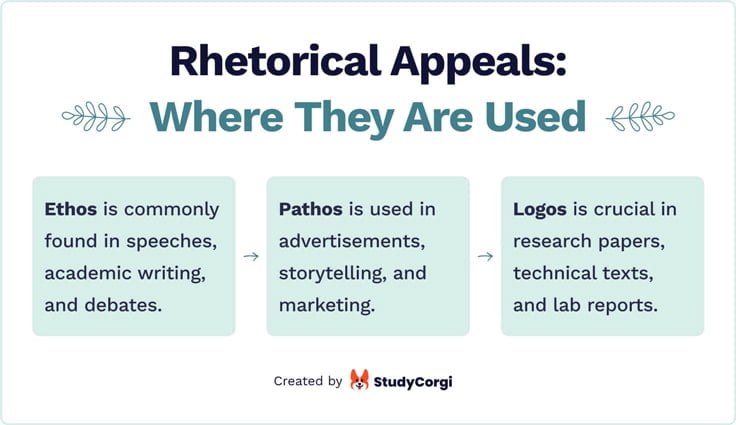🚀 How to Use a Rhetorical Analysis Essay Generator
Get a thorough rhetorical analysis of any text in 4 simple steps:
- Paste the text that you want to analyze into the empty field.
- Choose the type of your text from the drop-down list. You can choose between speech, presentation, commercial, or letter.
- Type in a background context. It's optional, though it will make the generated analysis more precise.
- Press “Analyze” and get the results!
🔥 Reasons to Use Our Tool
There are many good study tools out there, but our generator is one of a kind. Once you try it, you wouldn’t want anything else. Here’s why:
| 💸 100% free | Use it without limitations and spend your money on things you like. |
|---|---|
| 🤩 User-friendly | You can use it without experiencing any problems. |
| 🖥️ Works online | You don’t have to download anything or register an account. |
| 🤖 AI-based | Our generator is as intelligent and effective as it gets. |
| ⏰ Saves time | Creating a detailed analysis now takes only a few seconds. |
🎉 What Is a Rhetorical Analysis?
Rhetorical analysis is an in-depth review that uses literary principles to closely examine the connections between a text’s author, its audience, and the text itself.
A rhetorical analysis is not the same as a summary. While a summary retells the text, a rhetorical analysis argues how an author conveys their message to a specific audience. It investigates the author's intentions and techniques and evaluates their effectiveness.

Rhetorical Analysis Structure
Now, let's review parts of a rhetorical analysis and what each of them consists of.
Introduction
The introduction should provide background information about the text you are analyzing. This includes the author's name, the publication date, and the title. Remember to add a thesis at the end of your intro!
Body
The analysis itself is written in the main body. Every argument you include there has to follow a single concept. It can be either support or opposition to the writer’s claims.
Here’s a checklist that will help you create the main body:
- Describe the strategies the author used to educate, amuse, or persuade the audience.
- Analyze the motivation behind the text and its initial goals.
- State your arguments for or against the author’s ideas and support them with quotes from the text.
- Speculate about the audience's reactions and feelings.
Conclusion
Generally, a conclusion summarizes your entire analysis. Many students struggle with writing it. To avoid problems and mistakes, you can simply restate your thesis and retell the main ideas of your arguments from the main body.
Here’s a checklist of what to include in the conclusion:
- A brief generalization of your arguments.
- A restatement of a thesis from the introduction.
- An explanation of why the reviewed text matters to the audience.
- A summary that states why it was important to conduct this analysis.
✍️ How to Write a Rhetorical Analysis
This handy guide will teach you how to do rhetorical analysis correctly. It will help you conduct a thorough study and avoid common mistakes. Let’s get started!
Step 1: Examine Rhetorical Appeals
The first thing to do is to closely examine the appeals. They are the primary elements used by the text’s author to better appeal to the reader and produce a compelling argument. The 3 main types of rhetorical appeals are logos, ethos, and pathos.

Ethos
Ethos describes how the author uses their real-life status to pique the interest of an audience. Ethos-driven texts or speeches rely solely on the writer’s reputation and expertise. Therefore, in your rhetorical analysis, you should consider how the author builds up their ethos by using various techniques.
Pathos
Pathos aims to evoke strong feelings in the reader. Authors may use emotional language, share personal experiences, and use vivid imagery to arouse pity, anger, or other emotions in their audience.
Logos
The logic-based appeal, or logos, tries to persuade the audience by referring to facts, evidence, methodology, and arguments. In logos-driven texts, authors avoid mentioning anyone's reputation, emotions, or personal opinions.
Step 2: Apply SOAPS Tone Strategy
The College Board created a method called SOAPS Tone to simplify the process of conducting a rhetorical analysis. It is intended to assist you in comprehending the interactions between the writer and the audience.
To do a SOAPS Tone analysis, answer the questions below:
| Speaker | Whose voice is being heard within the text? What can you tell about the speaker? |
| Occasion | What is the time and place of the text? Are any real-life events connected to it? |
| Audience | Who is the audience? Does the text specify or name the audience? |
| Purpose | Why was this text created? How does the speaker convey its message? |
| Subject | What is the theme of the text? Is there more than one of them? |
| Tone | What are the author’s emotions and attitude? How does it reflect the text’s message? |
Step 3: Look into Claims, Supports, and Warrants
The texts will be empty and meaningless without claims, supports, and warrants. Your role as an analyst is to find and describe them in your essay's main body.
- Claims are the author’s ideas and statements.
- Supports are the evidence that speaks in favor of the author’s position and aim to persuade the reader.
- Warrants represent the author’s explanation of how supports and claims can influence each other.
Here’s an example:
"More Americans need to lose weight"—a claim which represents the writer’s position.
"According to statistics, 42% of American citizens have obesity"—that’s a support.
"By encouraging people to exercise, the government can decrease the obesity rate"—that’s a warrant that explains how the author’s earlier claim can be achieved.
Step 4: Formulate a Thesis Statement
A rhetorical analysis thesis should respond to the question of how successful the author was in persuading the audience. Its main goal is to clearly and briefly express your personal views regarding the claims made by the text's writer.
Here’s what we can advise you about writing a perfect thesis:
- A thesis statement is placed at the end of the introduction.
- It should not exceed 1 or 2 sentences in length.
- We recommend you to develop your thesis before you start writing: it will give you a framework for the entire main body of your analysis.
- Make sure that you’ll be able to support your thesis with facts and examples from the text.
Step 5: Create an Outline
Before writing anything, make a few drafts of a plan that will serve as a skeleton of your analysis. Briefly list your arguments and support each of them with proof. Now, you're ready to start writing.
Not sure what arguments to use? Or maybe the text's rhetorical devices are not entirely clear to you? Use our generator to create a perfect draft of your analysis!
Step 6: Write Your Analysis
Finally, it’s time to gather everything together and create an essay. Use the ideas from your outline and try to pay attention to each paragraph’s contents.
✨ Rhetorical Analysis Essay: Practical Tips
Writing a perfect rhetorical analysis can be hard, especially for inexperienced students. But worry not: our valuable tips below will help you create an excellent paper!
| Expand your experience. | Practice a few times before you start working on your assignment. Try writing a short rhetorical analysis of your favorite novels, TV shows, movies, or blogs. |
|---|---|
| Pick an interesting topic. | If you choose a subject that interests you, it will give you enough enthusiasm to write a better analysis. |
| Follow the format rules. | A rhetorical analysis should be written in the present tense and in the third person. |
| Pick your words carefully. | Avoid expressing personal viewpoints or beliefs since this kind of analysis aims to be impartial. Additionally, support each argument with direct quotations, facts, and examples. |
| Show your respect for the author. | Even if you disagree with their text, do your best to remain polite and neutral. |
| Use helper apps. | There is nothing wrong with using them to improve the quality of your work. If you’re stuck with your assignment, try our rhetorical analysis essay generator and see what it gives you. It will significantly boost your inspiration and provide you with fresh ideas. |
Now you know how to write a rhetorical analysis! Use this knowledge, and be sure to try out our free generator. It can make your analysis even better and save a ton of your time. Good luck!
We also recommend trying our research introduction maker and citation machine.
❓ Rhetorical Analysis Essay Generator FAQ
❓ How do I write a rhetorical analysis essay?
Start with an introduction where you write about the text’s background, the writer’s initial goals, and the importance of your analysis. Then, describe the literary appeals, evidence, and tactics the author employs. Rate their effectiveness and state your position regarding the text’s claims. Finally, conclude your analysis.
❓ What are the 5 points of rhetorical analysis?
The five components of rhetorical analysis are purpose, audience, topic, writer, and context. These components work together to fully define the situations and settings that the author implied. If they are correctly understood, they may guide you to an understanding of the main idea behind the analyzed text.
❓ What is the outline of a rhetorical analysis essay?
An outline is used to organize your rhetorical analysis. It enumerates the main arguments in a list or a table format. It includes 3 parts: an introduction with a thesis, the main body, and a conclusion.
❓ What are the 3 parts of rhetorical analysis?
Similar to other essay types of essays, a rhetorical analysis has an introduction that states the main idea, the main body that consists of multiple paragraphs, and a conclusion to tie everything together.